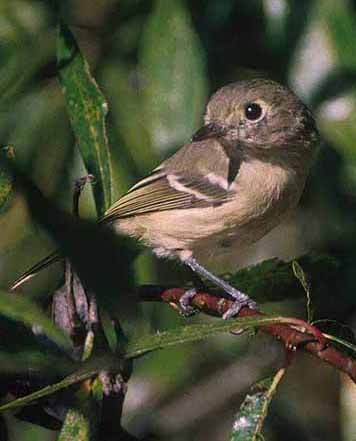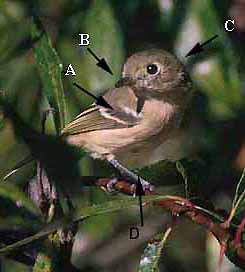 |
 |
 |
 |
A winter field identification problem in western North America (B.C. to California, west of the Cascades & Sierra Nevada) is separating Hutton's Vireo Vireo huttoni from Ruby-crowned Kinglet Regulus calendula. Hutton's Vireo is a resident of oak and mixed oak/pine woodlands along the coast and in the montane foothills while Ruby-crowned Kinglet winters in these areas in large numbers. In summer, the kinglet moves north to breeding grounds across Canada & Alaska, or up to higher elevations among coniferous forest. Resident and visitors to the West in winter need to be able to separate these two common birds. Those interested in county rarities need to be able to confirm a Hutton's Vireo in California's Central Valley (where it is quite rare but kinglet are common in winter). Those interest in status and distribution are sometimes confronted with claims of Ruby-crowned Kinglet in the summer in areas where it does not nest. For example, in Monterey County, California (where I live) the vireo is present year-round but the kinglet does not arrive in numbers until October and almost all are gone before April. The earliest arrival on record is 11 Sep 1995 at Carmel R. mouth, and most years the most one does not appear until the 3rd week of September. The latest spring record is one banded at Big Sur R. mouth on 13 May 1994. This means that for four months between mid-May and mid-September there are no Ruby-crowned Kinglets in Monterey County, although unsubstantiated claims are made from time to time. Knowing a bird's annual pattern is important to identification, and obviously one should be very skeptical if you feel you have a bird outside its pattern.
The smaller photos below (reductions of the two shots above plus one from the "Kinglet Family" page on this web site) highlight four areas of importance:
 |
 |
 |
The left-hand photo is a Hutton's Vireo; the two right-hand photos are Ruby-crowned Kinglets. The areas of distinction are (check them out on the large photos after orienting here):
Many field guides emphasize behavioral differences, calling the vireo slow and deliberate and the kinglet flitty, nervous, and active. Some of the literature emphasize wing-flicking in the kinglet. These points can be misleading. It is true that, in general, the Hutton's is more deliberate when feeding, but there are many times when it is more active. It will flick its wings, hover-glean, flit around nervously, and do all those behaviors typical of the kinglet. Don't rely on behavior.
Voice is a much better character and is diagnostic once learned. The oft-heard, soft rattle of the kinglet is a dominant sound in wintering mixed flocks; it has been described as a scolding "je-dit, je-dit," or "chiditdit" or a machine-gun "ah-a-a-a-a-a-a," but it is not the least bit whinny. The vireo gives a typical vireo scold, a whinny descending "whee-we-we-we," a nasal descending "cheee," or may sing its two-part monotonous upslurred "zuwee" or "chew-wheet" song on warm days at any time of year (sometimes a downslurred "zeeoo...zeeoo....zeeoo." In coastal California, serious singing by the vireo often begins in February when there are still a lot of kinglet around.
Two excellent articles on this topic, both of which I used to learn these birds better, are Kaufman (1977) and Stallcup (1984).
Photos: The Hutton's Vireo was photographed at the Carmel River mouth, Monterey County, California, on 16 Oct 1999. Both Ruby-crowned Kinglets were taken at MoonGlow Dairy, Moss Landing, Monterey County; the uppermost on 8 Oct 1998 and the last shot on 16 Nov 1998. All photos © Don Roberson; all rights reserved.
Literature cited:
Kaufman, Ken. 1977. Field identification of Hutton's Vireo. Continental Birdlife 1: 62-66.TOPStallcup, Rich. 1984. Focus: The eye-ringed leaf gleaners. Pt. Reyes Bird Observatory newsletter, summer 1984 issue, pp. 8-9.